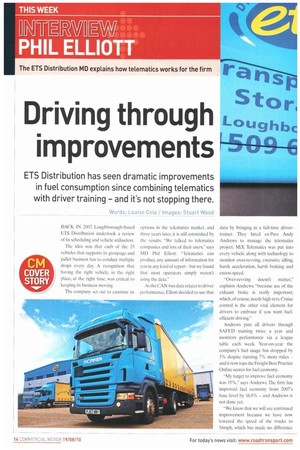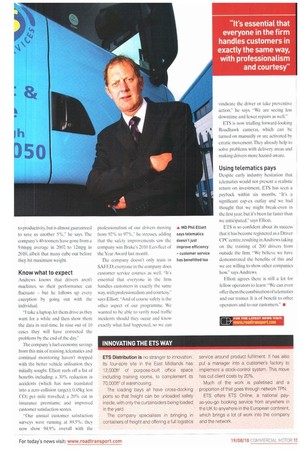Driving through improvements
Page 14

Page 15

If you've noticed an error in this article please click here to report it so we can fix it.
ETS Distribution has seen dramatic improvements in fuel consumption since combining telematics with driver training and it's not stopping there.
Words: Louise Cole / images: Stuart Wood
BACK IN 2007, Loughborough-based ETS Distribution undertook a review of its scheduling and vehicle utilisation.
The idea was that each of the 25 vehicles that supports its groupage and pallet business has to conduct multiple drops every day. A recognition that having the right vehicle, in the right place. at the right time, was critical to keeping its business moving.
The company set out to examine its options in the telematics market, and three years later, it is still astonished by the results. "We talked to telematics companies and lots of their users," says MD Phil Elliott. "Telematics can produce any amount of information for you in any kind of report-but we found that most operators simply weren't using the data."
As the CAN-bus data relates to driver performance. Elliott decided to use that data by bringing in a full-time drivertrainer. They hired ex-Para Andy Andrews to manage the telematics project. MiX Telematics was put into every vehicle along with technology to monitor over-revving, excessive idling, harsh acceleration, harsh braking and excess speed.
"Over-revving doesn't matter," explains Andrews, "because use of the exhaust brake is really important; which. of course, needs high revs. Cruise control is the other vital element for drivers to embrace if you want fuelefficient driving," Andrews puts all drivers through SAFED training twice a year and monitors performance via a league table each week. Year-on-year the company's fuel usage has dropped by 3% despite running 7% more miles and it now tops the Freight Best Practice Online scores for fuel economy.
"My target to improve fuel economy was 15%." says Andrews. The firm has improved fuel economy from 2007's base level by 16.8% and Andrews is not done yet.
"We know that we will see continued improvement because we have now lowered the speed of the trucks to 54mph, which has made no difference to productivity, but is almost guaranteed to save us another 5%," he says. The company's 40-tonners have gone from a 9.6mpg average in 2007, to 12mpg in 2010, albeit that many cube out before they hit maximum weight.
Know what to expect
Andrew's knows that drivers aren't machines. so their performance can fluctuate — but he follows up every exception by going out with the individual.
"I take a laptop, let them drive as they want for a while and then show them the data in real-time, In nine out of 10 cases they will have corrected the problems by the end of the day."
lbe company's fuel-economy savings from this mix of training, telematics and continual monitoring haven't stopped with the better vehicle utilisation they initially sought. Elliott reels off a list of benefits including: a 30% reduction in accidents (which has now translated into a zero collision target): 0.45kg less CO2 per mile travelled; a 20% cut in insurance premiums: and improved customer satisfaction scores.
"Our annual customer satisfaction surveys were running at 89.5%; they now show 94.9% overall with the professionalism of our drivers moving from 92% to 97%." he stresses, adding that the safety improvements saw the company win Brake's 2010 Eco-fleet of the Year Award last month, The company doesn't only train in SAFED: everyone in the company does customer service courses as well. "It's essential that everyone in the firm handles customers in exactly the same way. with professionalism arid courtesy." says Elliott. "And of course safety is the other aspect of our programme. We wanted to he able to verify road traffic incidents should they occur and know exactly what had happened, so we can vindicate the driver or take preventive action," he says. "We are seeing less downtime and fewer repairs as well."
ETS is now trialling forward-looking Roadhawk cameras, which can be turned on manually or are activated by erratic movement. They already help to solve problems with delivery areas and making drivers more hazard-aware.
Using telematics pays
Despite early industry hesitation that telematics would not present a realistic return on investment, ETS has seen a payback within six months. "It's a significant cap-ex outlay and we had thought that we might break-even in the first year, but it's been far faster than we anticipated." says Elliott.
EIS is so confident about its success that it has become registered as a Driver CPC centre, resulting in Andrews taking on the training of 200 drivers from outside the firm. "We believe we have demonstrated the benefits of this and we are willing to show other companies how," says Andrews.
Elliott agrees there is still a lot for fellow operators to learn: "We can even offer them the combination of telematics and our trainer. It is of benefit to other operators and to our customers." •
Fl+FOR THE LATEST NEWS VISIT:




























































































































